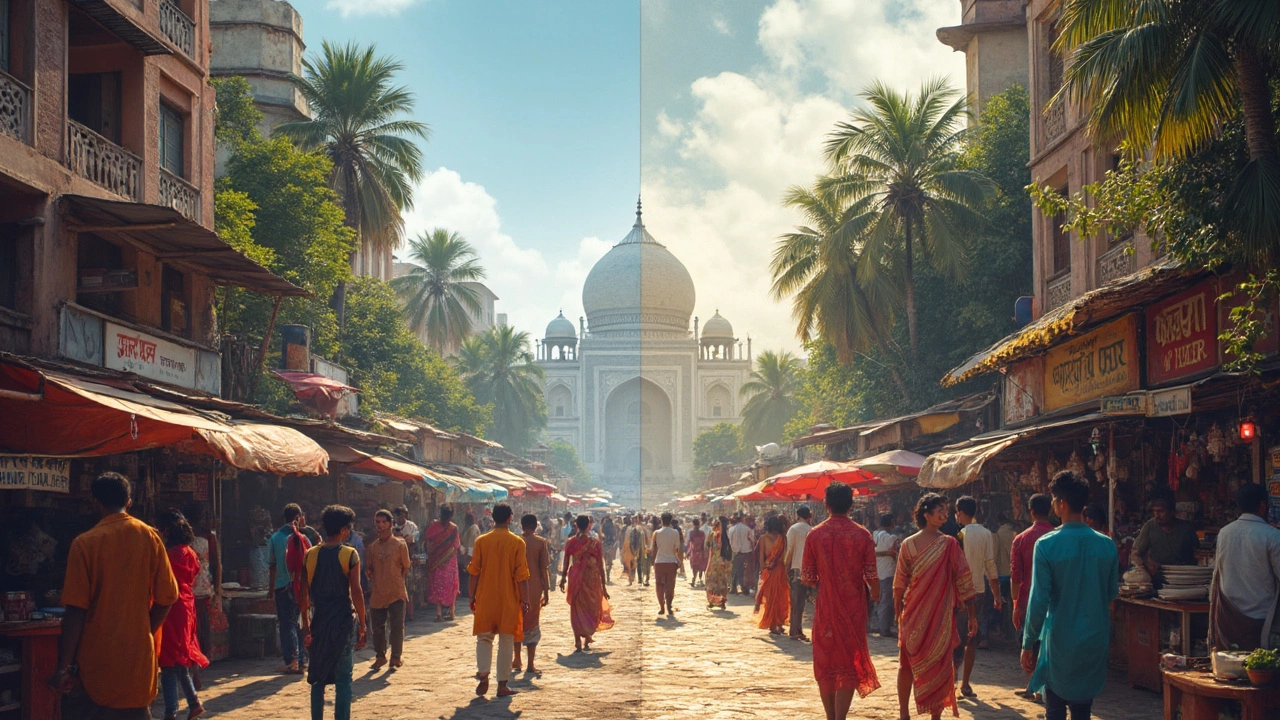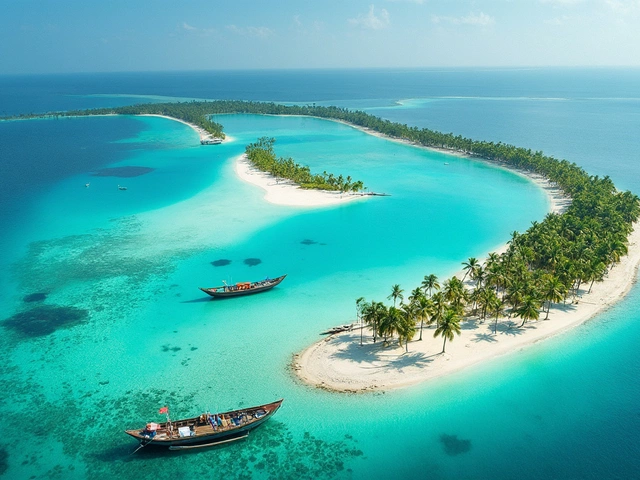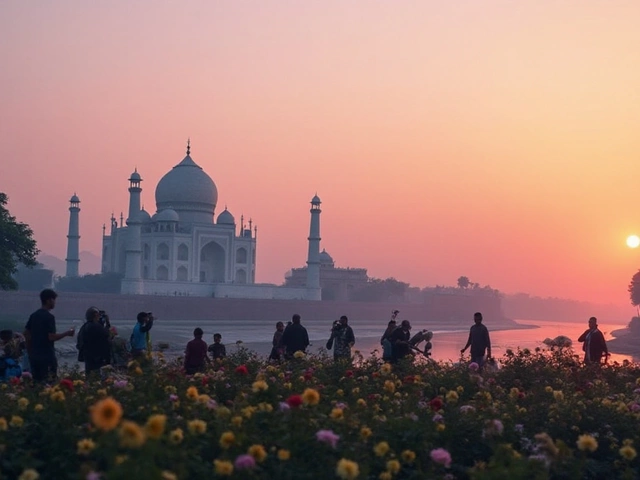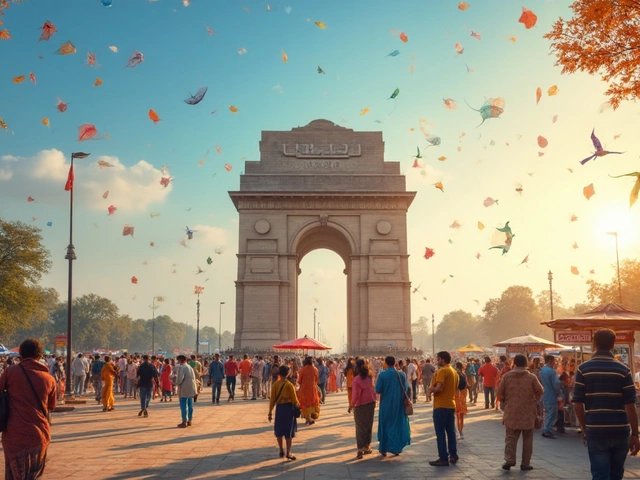Thinking about exploring India? Here’s what no guidebook tells you: North and South India aren’t just split on a map—they almost feel like two different countries. From the moment you step off the train or plane, you’ll sense it: the way people speak, the kind of food you smell, even the script on street signs.
Why does this matter? Every traveler, especially first-timers, can get caught off-guard by how day-to-day stuff changes when you move from, say, the heat of Delhi to the lush green hills of Kerala. If you know what to expect, you’re way less likely to end up awkwardly ordering the wrong kind of chai or wearing shorts where it’ll just make you stand out.
So if you want your trip to feel less like guesswork and more like smooth sailing, knowing the real differences between North and South India could save your skin. Let’s get into the stuff that actually counts for tourists—and get you ready for the best kind of adventure.
- The Basics: Geography and Language
- Food Wars: What’s on the Plate
- Festivals, Traditions, and Daily Life
- How People Dress: Colors, Fabrics, and Styles
- Best Places to Visit: A Quick Guide
- Travel Tips: Making the Most of Your India Trip
The Basics: Geography and Language
If you look at a map, India’s kind of sliced between the north and the south by the Vindhya mountain range. The north has places like Delhi, Agra, Rajasthan, and the Himalayas—think flat lands, deserts, and snowy peaks. South India drops below the Deccan plateau, and it’s packed with lush forests, long coastlines, and the Western and Eastern Ghats mountain ranges. So, that endless green you see in Kerala or the palm-lined beaches in Goa? That’s classic south.
Weather’s a big deal, too. North India is known for huge temperature swings. Winter in Delhi can get chilly, but summer goes above 40°C (104°F) fast. Meanwhile, most of South India sticks to a tropical vibe—hot, humid, and better if you like it sunny year-round, especially closer to the coasts.
Languages tell their own story. In North India, people generally speak Hindi, and a bunch of related languages like Punjabi or Urdu. You’ll see road signs, shops, and menus in Hindi and English. In South India, Hindi takes a back seat. Each state has its own Dravidian language: Tamil (Tamil Nadu), Telugu (Andhra Pradesh), Kannada (Karnataka), and Malayalam (Kerala).
- North: Hindi, Punjabi, Urdu, and more. Most folks know some English, so tourists rarely get stuck.
- South: Tamil, Telugu, Kannada, Malayalam, plus English. Knowing “thank you” or “hello” in the local tongue always scores smiles.
Here’s a quick comparison to give you the lay of the land:
| Region | Main Cities | Main Languages | Terrain | Climate |
|---|---|---|---|---|
| North India | Delhi, Agra, Jaipur, Varanasi | Hindi, Punjabi, Urdu, English | Plains, Deserts, Himalayas | Hot summers, cold winters |
| South India | Chennai, Bengaluru, Kochi, Hyderabad | Tamil, Telugu, Kannada, Malayalam, English | Plateaus, Forests, Beaches, Ghats | Tropical, humid, mild winters |
If you’re traveling, the difference in geography shapes everything—how long your train rides take, what you’ll wear, and what languages show up on your Google Maps. It’s not just north vs south—it’s a whole set of surprises launching as soon as you cross that invisible line.
Food Wars: What’s on the Plate
If you love to eat, India is a dream. But here’s the thing: what shows up on your plate in North India is often wildly different from what you’ll find down south. You might show up with a single idea of "Indian food," but you’ll quickly realize it’s not one-size-fits-all. If North India is all about thick curries and bread, South India keeps it light with rice and coconut.
Start in the north, and you’re looking at hearty meals. Think creamy butter chicken, paneer tikka, or stacks of hot naan and parathas fresh from a tandoor. Dishes here are packed with bold spices like garam masala, cumin, and coriander. North Indian food is generally less spicy than southern fare—but it’s heavier and richer. Go to someone’s house in Delhi or Lucknow, and they’ll probably serve you dal makhani (slow-cooked black lentils), kebabs, and fluffy basmati rice. People here live for their tea—and they mean chai, loaded with milk, sugar, and usually ginger.
Hop down to the south, and the whole scene flips. Instead of breads, you get dosas (giant, crispy rice crepes), idlis (steamed rice cakes), and sambar (a tangy veggie stew with lentils). South Indian food is big on tang, coconut, curry leaves, and mustard seeds. It’s lighter—more about flavors than cream. You’ll notice breakfast is a huge deal here, with people grabbing plates of vada (crispy lentil donuts) and chutneys before work. Coffee replaces chai, and it comes strong, sweet, and frothy—served the old-school way in steel tumblers.
| Dish | North India | South India |
|---|---|---|
| Staple Grain | Wheat (breads like naan, roti) | Rice (in almost every meal) |
| Main Curry Base | Cream, tomatoes, onion | Coconut, mustard seeds, tamarind |
| Popular Breakfast | Paratha, poori, chai | Dosa, idli, strong filter coffee |
| Common Spices | Garam masala, cumin, cardamom | Curry leaves, mustard seeds, dried chili |
| Snacks | Samosa, chaat | Bonda, banana chips |
Eating out? Northern cities like Amritsar are famous for their street food—try chole bhature, a spicy chickpea curry with puffy fried bread. Down south, try a banana leaf meal for the full experience. You’ll get a heap of rice with loads of tiny veggie sides, and eating with your hands is part of the fun.
One more thing: vegetarians have it pretty good on both sides, but South India is especially friendly for non-meat eaters. Don’t be afraid to ask for less spice if you’re not used to chili heat, especially down south—they don’t hold back.
Quick tip—if you’re not into super spicy food, North Indian stuff is safer ground. But if you want to try something funky and different, South Indian food will totally shake up your expectations.
Festivals, Traditions, and Daily Life
If you land in North India during October, prepare for the explosion of lights and noise that is Diwali. The north goes wild for this festival—think firecrackers, sweets piled high, and city streets glowing all night. On the flip side, in South India, the big deal is Pongal in January. It’s all about harvest, thanks, and food that’s heavy on rice and jaggery. Sure, both regions mark major festivals, but many are celebrated way differently.
Another big divider? Weddings. North Indian weddings often go on for several days and involve loads of singing, dancing, and some seriously ornate outfits. Down south, you’ll see temple weddings using fragrant flowers and silk saris, usually starting early in the morning. South Indian ceremonies are often shorter, but just as colorful.
When it comes to daily life, the rhythm’s unique. Early mornings in the south might start with strong filter coffee and a visit to the temple before work. In the north, chai is the king and neighborhood markets hum late into the evening. The languages people speak are just the start—all the small habits, like eating with hands (that’s pretty much everywhere) or wearing a lungi in the south versus a kurta-pajama up north, make each place feel distinct.
Some common cultural facts North vs South travelers notice:
- North Indians generally greet with "Namaste" and South Indians with "Vanakkam" (Tamil) or "Namaskara" (Kannada, Telugu, Malayalam).
- Rice is the staple in the south, while wheat (usually as roti or naan) is bigger in the north.
- Many North Indian cities get super busy during Holi, the festival of colors, while Onam turns Kerala into one big floral and food celebration.
Here’s a quick comparison for travelers:
| Festival | North India | South India |
|---|---|---|
| Diwali | Massive celebrations; fireworks, lights everywhere | Mainly in Tamil Nadu and Karnataka, celebrated differently |
| Holi | Huge event—colors thrown everywhere | Low-key or regional |
| Pongal / Sankranti | Observed but not widespread | Major holiday; harvest rituals |
| Onam | Rare/not celebrated much | Kerala’s biggest festival—floral carpets, boat races |
If you’re planning to take part, here’s a tiny tip: always ask before joining in—locals love sharing, but every area has its own ways and rules. A friendly smile and a question go a long way wherever you travel in North India and the south.
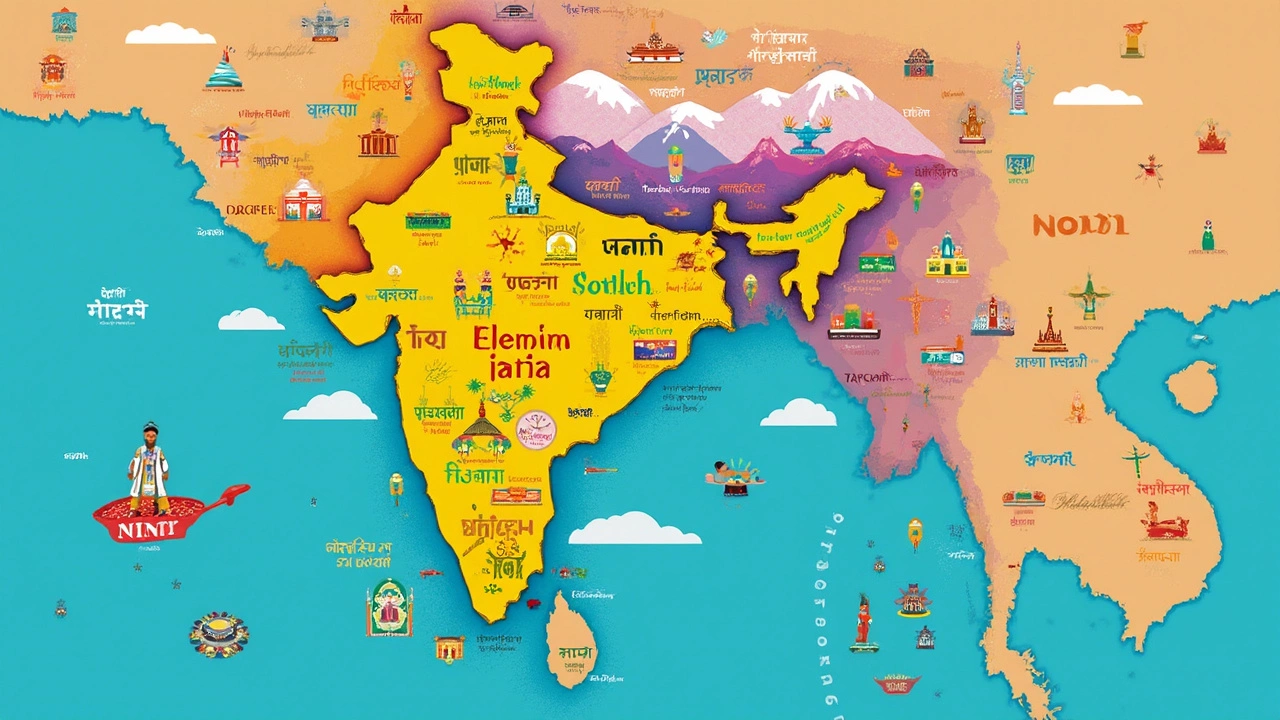
How People Dress: Colors, Fabrics, and Styles
It's wild how quickly your packing list changes once you cross from North to South India. Let's be real—clothes are a huge part of the culture. In the North India scene, you’ll see women rocking salwar kameez and men in kurtas with churidar or trousers. Sarees are still common for weddings and big events, but daily life usually means lighter, layered outfits, especially with North India's chill in winter. Winters in Delhi? Bring a jacket. Summers? Loose cotton all the way.
Take a train down to the South and you’ll spot a massive shift. Down here, the saree isn’t just for fancy days—it’s everywhere, every day. But it’s a different look: sarees are often made from light cotton or silk, like those famous Kanjeevaram varieties in Tamil Nadu. They’re bright, bold, and sometimes woven with gold borders. Men mostly stick with the dhoti (which locals call veshti or mundu), and you’ll see a lot more lungis—those checked wraparounds that signal comfort, especially in Kerala.
"India’s regional clothing differences aren’t just fashion—they’re tied to climate, tradition, and even how people move and work every day," says Dr. Ritu Kumar, a leading Indian fashion designer.
The reason for all these changes? Climate’s a biggie, but so is tradition. South India gets seriously hot and humid, so light, breathable fabrics are the only game in town. North Indians add shawls, jackets, or even those cool embroidered vests during the winter months.
- North: Look for phulkari embroidery, juttis (fancy slip-ons), and lots of layers as folks fight off the cold.
- South: Silk sarees are a go-to for celebrations, and plain white with gold borders is a classic for festivals. Men often go barefoot indoors, so keep your shoes tidy at the door.
If you’re hoping to blend in, skip the shorts in holy places and temples—long pants or skirts work everywhere. And if you’re buying clothes as souvenirs, watch for local markets selling unique handwoven fabric you won’t find anywhere else (Mysore silk, anyone?).
Best Places to Visit: A Quick Guide
If you think India is all about Taj Mahal selfies, you’re missing out. There’s way more out there, and a bunch of options no matter if you land in the North or South. Here’s the stuff that actually gets travelers excited—and where you’ll want to point your camera (and your feet).
- North India steals most of the headlines, and for good reason. You’ve got the capital, Delhi, with its chaos, crazy street food, Red Fort, and the quiet pockets like Lodhi Gardens. Agra is an obvious must because, yes, the Taj Mahal really does live up to the hype. Jaipur rounds out the Golden Triangle and hits you with pink palaces, forts, and shopping that’ll eat up your rupees fast.
- If you love the mountains, head further north to Himachal Pradesh or Uttarakhand. Shimla and Manali are cooler, hilly spots for hiking and escaping the summer blaze. Rishikesh pulls in a spiritual crowd and also lets you try river rafting down the Ganges.
- In the northeast, Varanasi stands out—the place where people go for spiritual journeys, sunrise boat rides on the Ganga, and a vibe you won’t get anywhere else.
- South India feels different right from the jump. Kerala is known as ‘God’s Own Country’ for its chill vibe, palm-lined beaches, houseboats, and spicy seafood. Check out Alleppey for the backwaters, Munnar for tea plantations, and Kochi if you want a city with a mix of everything.
- Karnataka ups the game with Hampi’s wild old ruins and Mysuru’s palace. Goa is the party spot, but the real win is its old churches, seafood, and relaxed beaches—not just the nightlife.
- If temples are your thing, Tamil Nadu has you covered with Madurai’s Meenakshi Temple and the towering gopurams in Chennai, plus cool French vibes in Puducherry.
| Region | Popular Cities/Towns | Main Attractions |
|---|---|---|
| North India | Delhi, Agra, Jaipur, Rishikesh, Shimla, Varanasi | Taj Mahal, Red Fort, holy Ganges, Himalayan hills, historic forts |
| South India | Kochi, Alleppey, Munnar, Mysuru, Hampi, Chennai, Goa, Madurai | Backwaters, beaches, tea gardens, old temples, colonial towns |
Don’t just stick to the big cities. Try small towns and off-beat spots too. And if you’re gunning for fewer crowds, skip weekends and local festivals unless you really want the full-on experience (and don’t mind the lines). If your main goal is North India adventure, hit the Golden Triangle or the Himalayan hill stations. For mellow weather, Kerala’s winter is great—while the north is best before the summer heat kicks in.
Travel Tips: Making the Most of Your India Trip
When planning your journey between North India and South India, you've got to keep a few key things in mind. The basics—weather, local rules, and getting around—can change big time depending on where you are.
The north gets super cold in winter, especially places like Delhi and Kashmir, while the south stays warm even in January. Monsoons hit the south hard from June to September, so pack light, fast-drying clothes if you visit during these months.
Here’s a quick reality check comparing travel facts for North and South India:
| Feature | North India | South India |
|---|---|---|
| Best travel season | October–March | November–February |
| Common languages | Hindi, Punjabi, Urdu | Tamil, Telugu, Malayalam, Kannada |
| Street food cost (average) | ₹50–₹100/meal | ₹40–₹90/meal |
| Popular transport | Rickshaws, Metro, Trains | Auto-rickshaws, Local Buses, Trains |
Make sure to respect local dress codes; temples in the south, like in Tamil Nadu or Kerala, often won’t let you in with shorts or sleeveless tops. Carry a scarf or shawl. In the north, you’ll need to layer up during winter mornings but can shed those layers by noon.
Trains are the lifeline here, but booking ahead is a must—seats fill up fast, especially on tourist-favorite routes like Delhi to Varanasi or Bangalore to Kochi. Grab a SIM card at the airport for cheap data—it’s a lifesaver for maps, translations, and train bookings on the go.
If you’re eating street food, look for the stalls busy with locals—the turnover means fresher stuff. Don’t miss the iconic chai in the north and filter coffee in the south for less than ₹30 a cup. Also, always carry a bottle of water and some hand sanitizer. Trust me, stomach bugs are easier to avoid than cure.
Last tip: budget a little extra for guided tours at heritage spots—having a local explain what you’re seeing takes your trip from good to unforgettable. India rewards the curious, but it pays to come prepared.
